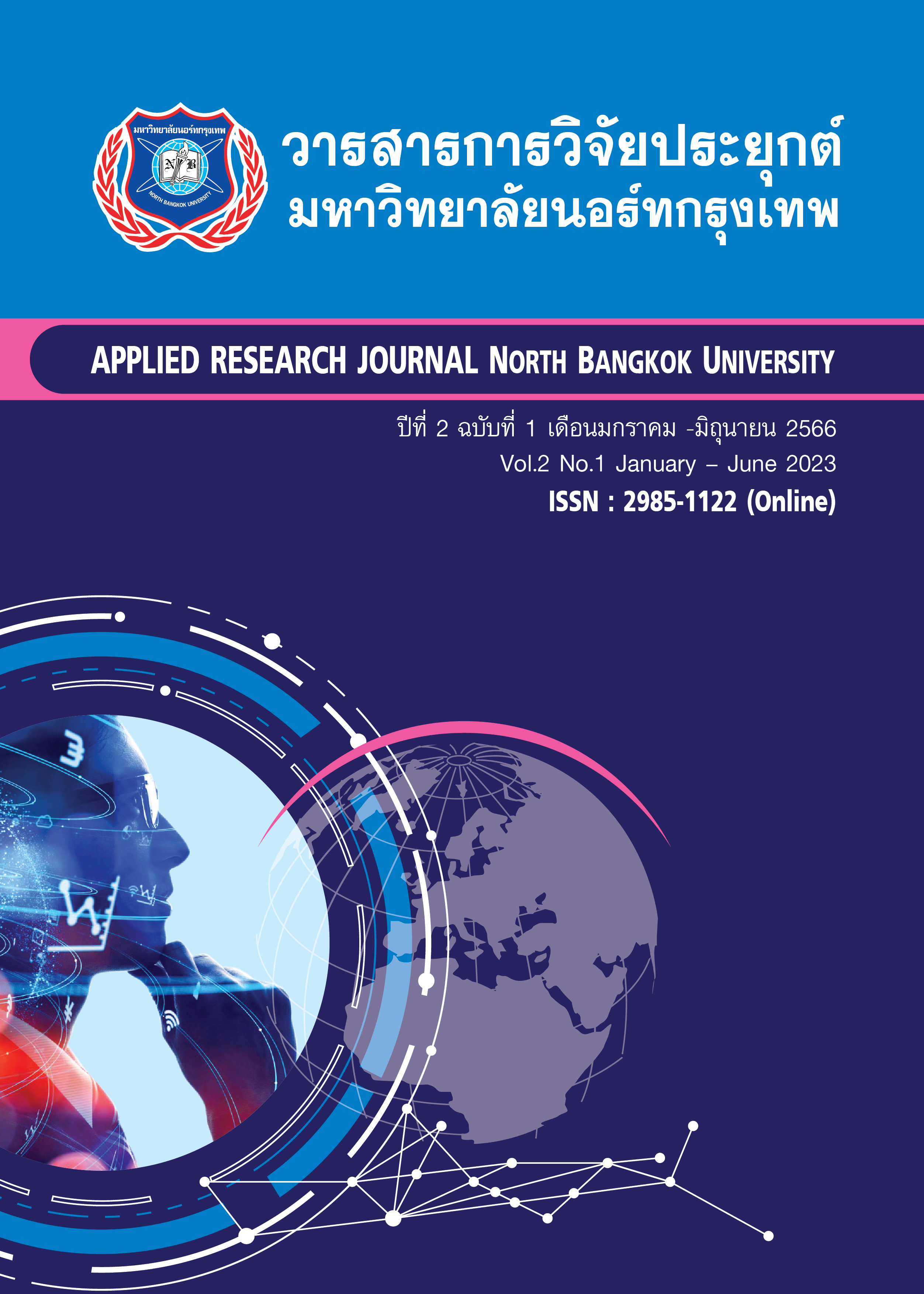ความคิดเห็นของประชาชนต่อการบริหารทุนมนุษย์ขององค์การบริหารส่วนจังหวัดปทุมธานี
Main Article Content
บทคัดย่อ
การวิจัยนี้มีวัตถุประสงค์เพื่อ 1) ศึกษาระดับความคิดเห็นของประชาชนต่อการบริหารทุนมนุษย์ขององค์การบริหารส่วนจังหวัดปทุมธานี 2) ศึกษาความคิดเห็นของประชาชนต่อการบริหารทุนมนุษย์ขององค์การบริหารส่วนจังหวัดปทุมธานีจำแนกตามปัจจัยส่วนบุคคล โดยใช้รูปแบบการวิจัยเชิงปริมาณ เก็บข้อมูลด้วยแบบสอบถาม กลุ่มตัวอย่าง คือ ประชาชนในจังหวัดปทุมธานี จำนวน 385 คน คำนวณโดยสูตรของเครซี่และมอร์แกน เครื่องมือที่ใช้ได้แก่แบบสอบถามแบบประมาณค่า 5 ระดับ ซึ่งมีค่าเชื่อมั่นทั้งฉบับเท่ากับ 0.705 สถิติที่ใช้ในการวิเคราะห์ข้อมูลได้แก่ ความถี่ ร้อยละ ค่าเฉลี่ย ส่วนเบี่ยงเบนมาตรฐาน การทดสอบ t-test, F-test ผลการวิจัยพบว่า 1) ปัจจัยส่วนบุคคลของกลุ่มตัวอย่างส่วนใหญ่เป็นเพศหญิง ร้อยละ 51.9 มีอายุ 31-40 ปี ร้อยละ 50.1 รายได้ 10,001-15,000 บาทต่อเดือน ร้อยละ 42.30 มีการศึกษาระดับมัธยมศึกษา ร้อยละ 43.7 ประกอบอาชีพพนักงานบริษัทเอกชน ร้อยละ 40.80 มีสถานภาพการโสด ร้อยละ 59.5 2) ระดับความคิดเห็นของประชาชนต่อการบริหารทุนมนุษย์ขององค์การบริหารส่วนจังหวัดปทุมธานี พบว่า โดยรวมอยู่ในระดับมากทั้ง 6 ด้าน ผลการเปรียบเทียบความคิดเห็นของประชาชนต่อการบริหารทุนมนุษย์ขององค์การบริหารส่วนจังหวัดปทุมธานี จำแนกตามปัจจัยส่วนบุคคลของกลุ่มตัวอย่าง พบว่า กลุ่มตัวอย่างที่มีรายได้ต่างกัน สถานภาพสมรสต่างกันมีความคิดเห็นต่อการบริหารทุนมนุษย์ขององค์การบริหารส่วนจังหวัดปทุมธานีแตกต่างกันอย่างมีนัยสำคัญทางสถิติที่ระดับ .01 กลุ่มตัวอย่างที่มีอายุต่างกัน ระดับการศึกษาต่างกันมีความคิดเห็นต่อการบริหารทุนมนุษย์ขององค์การบริหารส่วนจังหวัดปทุมธานีแตกต่างกันอย่างมีนัยสำคัญทางสถิติที่ระดับ .05
Article Details

This work is licensed under a Creative Commons Attribution-NonCommercial-NoDerivatives 4.0 International License.
Journal of TCI is licensed under a Creative Commons Attribution-NonCommercial-NoDerivatives 4.0 International (CC BY-NC-ND 4.0) licence, unless otherwise stated. Please read our Policies page for more information...
References
กัมปนาท ศิริพันธุ์. (2550) ความพึงพอใจของผู้ใช้บริการและเพื่อเปรียบเทียบความพึงพอใจของผู้ใช้บริการต่อการให้บริการของสำนักงานเทศบาลเมืองพะเยา. การค้นคว้าแบบอิสระบริหารธุรกิจมหาบัณฑิต. เชียงใหม่ : บัณฑิตวิทยาลัย มหาวิทยาลัยเชียงใหม่.
ฟ้าวิกร อินลวง. (2561). การจัดการทุนมนุษย์สมัยใหม่ ยุคเจนเนอเรชั่น วาย ระดับปฏิบัติการ : กรณีศึกษาสถานประกอบการในนิคมอุตสาหกรรมภาคเหนือ ลำพูน. วารสารวิชาการมหาวิทยาลัยธนบุรี. 12 (ฉบับพิเศษ).43-55. https://www.thonburi-u.ac.th/Journal/Document/12-Special/Journal12_Special_4.pdf
ดนัย ผ่องแผ้วและคณะ. (2564). ทุนมนุษย์ : การจัดการทรัพยากรมนุษย์ในองค์กรภาครัฐ. Journal of Modern Learning Development. 6 (5).289-302. http://www.mpa-mba.ru.ac.th/images/Project/sisaket02/6327952001.pdf.
ธมลวรรณ พงษ์สถิตย์. (2557). การศึกษาแนวทางการพัฒนาสถานศึกษา สังกัดเขตพื้นที่การศึกษkพระนครศรีอยุธยา. [วิทยานิพนธ์หลักสูตรปริญญาครุศาสตรมหาบัณฑิต]. อยุธยา: มหาลัยราชภัฎพระนครศรีอยุธยา.
บุญเรียง ขจรศิลป์. (2549). สถิติวิจัย. (พิมพ์ครั้งที่ 9). นนทบุรี: โรงพิมพ์พีเอส. พริ้นท์.
ภาราดร อมรเวทีและคณะ. (2561). รูปแบบการจัดการทุนมนุษย์เชิงพุทธขององค์กรปกครองส่วนท้องถิ่นจังหวัดนครสวรรค์. วารสาร มจร.สังคมศาสตร์ปริทรรศน์, 7(2),104-115,(ฉบับพิเศษ). https://so03.tci-thaijo.org/index.php/jssr/article/view/245690/166213
อภิชาติ พานสุวรรณ. (2561). ความคิดเห็นของประชาชนต่อการบริหารทุนมนุษย์ขององค์การบริหารส่วนจังหวัดพระนครศรีอยุธยา. คณะวิทยาการจัดการ มหาวิทยาลัยราชภัฏพระนครศรีอยุธยา.
อภิชาติ พานสุวรรณและวิชชุกร นาคธน. (2563). ความคิดเห็นของประชาชนต่อการบริหารทรัพยากรมนุษย์ขององค์การบริหารส่วนตำบลกรณีศึกษา องค์การบริหารส่วนตำบลรางจระเข้. วารสารวิชาการมนุษยศาสตร์และสังคม.8(2), 127-143.https://so03.tci-thaijo.org/index.php/husoarujournal/article/view/256718
Krejcie, R. V. & Morgan. D. W. (1970). Determining Sample Size for Research Activities. Educational and Psychological Measurement. 30 (3). , 607-610.
Mondy, R. W. & Noe, R. M. (1996). Human Resources Management. New York: Prentice Hall Werther.
Keith D. (1985). Personal Management and Human Resources. (2nd ed). New York: McGraw-Hill.

